Mordialloc Carnival 1923-1939
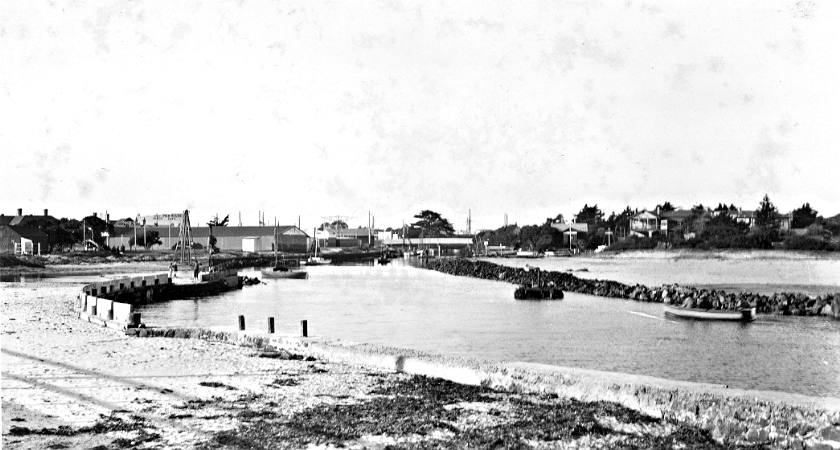
Mordialloc Creek from its mouth looking towards the bridge. The Mordialloc Carnival is to the left, 1934. Courtesy Mordialloc and District Historical Society.
Throughout history in Christian countries a carnival was the occasion for feasting and merrymaking, usually on a regular date and involving a procession. Shrove Tuesday was one such carnival date when people had some fun before the Lenten fasting began. These carnival processions still take place in some South American countries, and there are others in the ‘nominally Catholic’ countries of southern Europe.
In our district, though other towns have had these celebrations, it is Mordialloc that has the most notable history of carnivals, but there is no evidence that they had any religious aspect, their dual purpose being to have fun and raise money. In the mid-twentieth century the annual, summer-holiday Mordialloc Carnival was part of the town’s attractiveness for leisure-seeking visitors to the beach. However, the town’s first carnivals were held well over a hundred years ago, beginning in 1908. They were held on a chosen day and began with a procession from Beach Road up High Street to the Main Street and back to the sports-ground near the shore, about where Windows By The Bay in Scullin Reserve is now. Then picnic races and novelty events took place, sometimes followed by a concert. Prizes were given for vehicles with the best decorations and for people whose fancy dress outfits were judged as the best in various categories. The first carnivals were held in June, but by 1912 they moved the date to ANA Day in January (now Australia Day) to enjoy the warmer weather. [1]
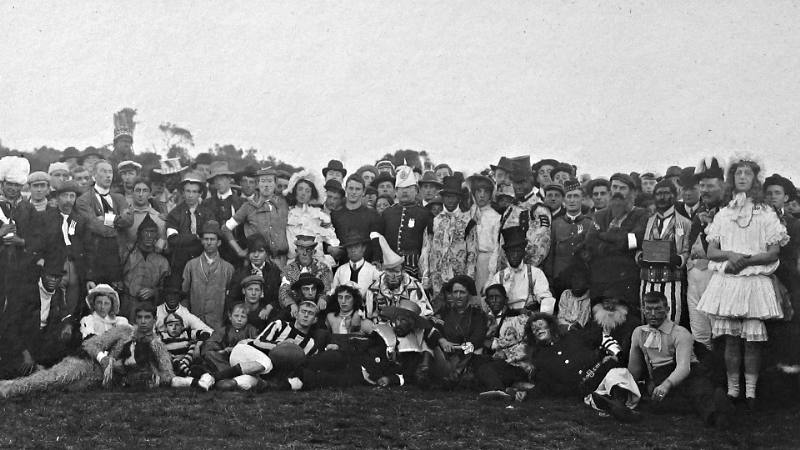
Fancy dress at one of the early Mordialloc Carnivals, 1908. Courtesy Mordialloc and District Historical Society.
In this era there were seven one-day carnivals, the last being in 1914, after which the Great War caused such events to be abandoned, with so many men overseas and more resources needed for the war effort. The procession, led by the town band, always began the day’s celebrations, and though the route was varied in some years, it always took the participants to the sports ground that existed in the open park that is now Scullin Reserve. People then took part in novelty events: races for married men, or single men; married ladies races and single women’s events; children’s events for various ages; high jump contests; tug of war battles; and hurdle races. Then came displays of the Highland Fling, Irish Jig and Sailors Hornpipe, with prizes for the best dancers. During the procession judges assessed which decorated vehicles were the best in many categories, as well as deciding who among the people in fancy dress had the best or the funniest outfits. Later in the day these results were announced and there was great acclaim from the crowd. Apparently the attendances were quite large with thousands arriving by train from many suburbs, according to the Moorabbin News reports on the annual events. The 1913 carnival was hailed as the most successful and most profitable, but, surprisingly, in 1914 interest waned and the committee simply ran a smaller event in June which ended in a fancy-dress football match followed by movies in the Mechanics Hall.
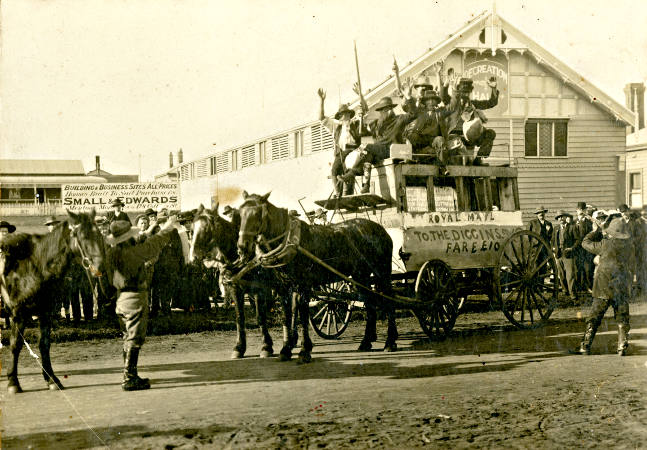
‘Off to the Diggings’. A float in an early Mordialloc Carnival parade, 1910. Courtesy Jenene Nelson, Kingston Collection.
These carnivals of the Edwardian era raised money that was shared among various local clubs and other groups. Among those mentioned in reports were the bowling club and its croquet club affiliate, the football club and the Mordialloc Band.
After the Armistice in 1918 it took several years for normality to return. For one thing, in 1919 there was a disastrous influenza epidemic that took many lives and shut down a lot of social activity. In Mordialloc no carnival took place until the summer of 1923-4. In October of 1923 the first in a series of 12 committee meetings took place with the aim of running a carnival to raise money so that a rotunda-type bandstand could be built in the beach park near the pier. The brass band was a local institution that people appreciated and its members became part of the carnival organising group. Also, at the time the Mordialloc Progress Association was lending support to Council, and lobbying them for beautification of the foreshore. Prominent citizens and members of local clubs were drawn into this campaign as the small carnival committee contacted them and invited more people to join the movement. The prime movers included Messrs Brine, Phillips, Nicholson, Comport, Syle, Cottrell and McQueen. These people hoped to make Mordialloc more prosperous by attracting visitors, and saw public entertainment as a way to do that. Edward Brine was the bandmaster, while Phillips and Nicholson were real estate agents who naturally pushed for bringing crowds into the town, hoping some would want to come back, buy property, and become residents.
The committee went into great detail about how the carnival should be run. It was decided to have it on A.N.A. Day, the 28th January (a Monday holiday, at that time always held near to or on the 26th January). Much discussion went on about hiring a merry-go-round, hoopla stalls, musicians, side-shows and other performers. The horse-drawn mower from Mordialloc Golf Club (later Woodlands) was borrowed to trim the grassy beach park. The committee also went back to opening up with a procession which was to wind its way from Beach Road to Main Street and then do a circuit up Epsom Road to Main Street again, finally ending up in the beach park. Then all the fun of the fair went on with a great profit coming in at the end. Mordialloc traders and others donated prizes for the raffles, volunteers manned the various stalls, and the day was voted a resounding success. An area near the creek at the end of the park and close to the pier saw the crowds flock to side-shows, the merry-go-round and other entertainments. Around £125 was raised, a considerable sum at that time. The new Mentone-Mordialloc Council, recently separated from Moorabbin Shire, also contributed some assistance. A ‘showman’, J Briggs, provided the merry-go round and other attractions and received half the takings.
The success of this carnival in January 1924 stimulated interest in planning another carnival for the next summer. Late in the year a series of meetings arranged a much larger carnival for the Christmas holiday period. It opened on Christmas Eve and ran until New Year’s Day and then at weekends until January 31 1925. All the attractions were again hired from Briggs who received half the money raised, the one exception being a jazz palais, run in a marquee with a timber floor, where patrons paid for each dance to the dixieland beat of a hired band. A fancy dress procession, a children’s day with many footraces, and a burlesque horse race were other features. This carnival grossed 2840 pounds, an exciting success that allowed the committee to build the Band Rotunda in the beach park and stage its opening ceremony just before the next carnival began at Christmas, 1925. From then on the carnival opened just prior to Christmas and times gradually extended each year until it ran daily, except on Sundays, until the end of January. After 1930 the show went on until Easter, but only on Saturday nights after ANA Day, with extra openings on special days such as public holidays. The extension of carnival show times happened because of the amazing popularity of the summer fair. On Boxing Day 1927 50,000 people attended the carnival grounds throughout the day.
During the late 1920s the carnival grew in popularity and the annual gross takings rose to well over 4000 pounds, before falling back by several hundred pounds each year in the early 1930s depression. The area near the creek became the permanent site for the event and when the committee began buying capital items such as the Dodgem Cars, Hoop-la stalls, ticket boxes and other items these were eventually housed in timber structures that stayed put all year round. The merry-go-round was bought through a loan by W Green J P, a carnival committee president and Parkdale resident who offered generous terms for repayment. The large profits through the twenties were used to build a sea wall and promenade near the beach park and shelter sheds, as well as permanent jazz palais building. The popular merry-go-round was surrounded by a protective timber building so that customers could avoid inclement weather. Lawns were planted in the park area and a running track for picnic sports was fenced. Mordialloc’s beautification captured much attention.
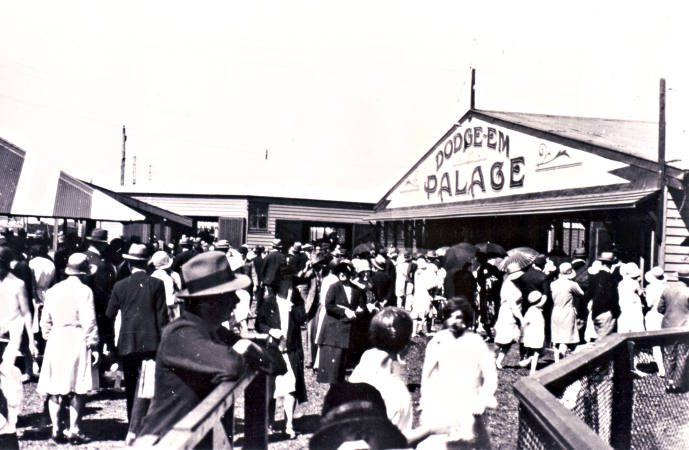
Crowd outside Dodge-em Palace with merry-go-round shed in background, 1928. Courtesy Mordialloc and District Historical Society.
None of this happened by just good luck. The committee and volunteers numbered more than 120 each summer by the end of the decade. Many local businesses contributed support in money and goods that could be used as prizes in carnival events. The committee worked zealously on promotion of the carnival. They cultivated support at local council level and also from State and Federal Governments. Radio stations pushed the carnival along with newspapers, both local weeklies and the Melbourne dailies. Carnival committees were led by councillors and local businessmen, including H Phillips, Cliff Caudwell, Dave White, Edward Brine, William Green, R Hogg and A Hill. The committee managed to have two Australian Prime Ministers open the carnival. In 1927 and 1928 Stanley Bruce opened the event and James Scullin officiated in 1929 and 1931. Bruce was the member for Flinders which then took in Mordialloc, so he had an interest in his constituents’ wellbeing, and later prime ministers were probably told by the committee that it was traditional for the nation’s leader to officiate, the carnival being such a paramount event. Joe Lyons, PM from 1932 till 1939, never opened the carnival, always sending a government minister, until the committee reverted to local State politicians, or, on the occasion of the Centenary year, 1934, the Governor, Lord Huntingfield. In 1932 Stanley Bruce was Australia’s resident minister in London and the committee arranged for the ex-PM to open the carnival by beam wireless from Nice in France where he was holidaying. The ABC broadcast Bruce’s words to the gathered throng who marvelled at this new wonder of wireless technology. At this time the opening ceremony took place in the carnival grounds but later on there were other venues including the nearby Pier House Café.
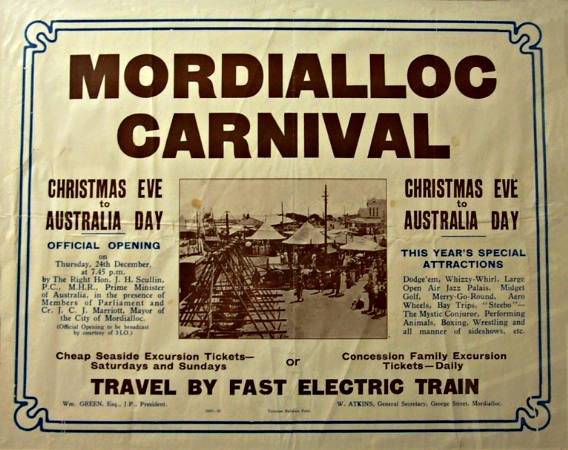
Poster advertising the opening of the Mordialloc Carnival by the Prime Minister of Australia, The Right Hon. J. H. Scullin, and the broadcasting of the event by 3LO, 1931. Courtesy, Hazel Pierce, Kingston Collection.
By the time of the depression in the early thirties Mordialloc Carnival was a landmark summer festival, known far and wide, and attended by many tens of thousands each year. The financial contribution to capital works around the foreshore was of enormous local significance; the beachfront became attractive for holiday-makers, while from 1929 the creek entrance was dredged and its banks reinforced with sheet-piling using carnival money matched on an equal basis with State funds.
The Great Depression dented carnival gross takings for a year or so but the whole enterprise was too important for that to last and the 1930s saw Mordialloc’s summer funfair increase in popularity even further, as annual takings rose to nearly 7000 pounds on the eve of World War 2. The carnival by then included extra attractions: the Whizzy Whirl, Madame Carlreno (the snake charmer), performing dogs, monkeys and ponies, a miniature railway, Giggleville, electric poker, penny squares and many more. A boxing tent lured game young men who tried to win prizes by out-boxing the promoter’s pugs. These shows went on for weeks as the crowds flocked in. Committee men spent some of the takings on improving the grounds, with bigger offices, a theatrette, jazz palais extensions and brighter floodlights. The rest went to building extensive beach shelter sheds and concrete footpaths near the shore, tree-planting, work on the creek and extending the lawns.
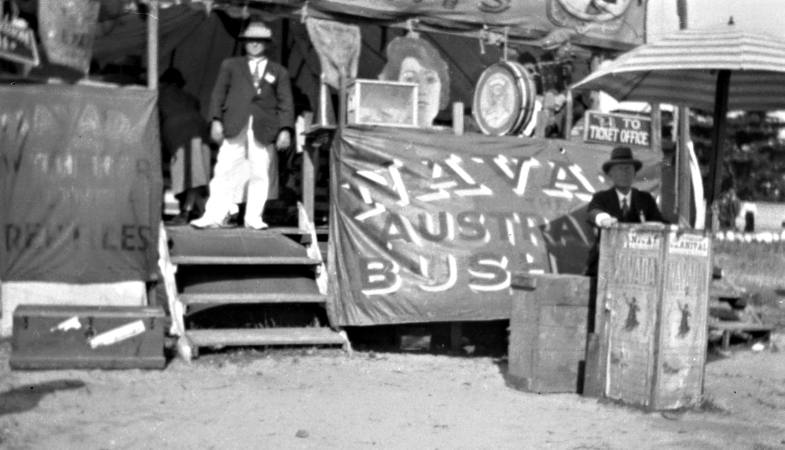
Side show attraction. This venue has Australian animal displays and other attractions, c1930. Courtesy Mordialloc & District Historical Society.
No effort was spared in order to bring in the crowds. On New Year’s Eve in 1933, close to midnight, Ozzie Nicholson, then one of Australia’s top cyclists, pedalled into Mordialloc Carnival grounds to complete his record-breaking ride of just over 43,066 miles, then a world record for the longest cycle ride in one calendar year. The next summer the Mordialloc Grand Prix, a 50 km cycle race around the circuit of Beach Road, George and Bay Streets and Nepean Road, attracted top cyclists. Cycling as a sport was of great popularity at that time, especially in the Mordialloc district, as Hubert Opperman was a local man and a world class rider, having done well in the Tour de France. Oppy and Nicholson did not compete in the Mordialloc Grand Prix. Opperman was injured and Nicholson competed elsewhere. But the publicity build up to this race went on for weeks, Oppy being very much part of that. A New Zealand rider called Ralston beat the big names, some from interstate, and claimed the prize money. The creator of Malvern Star cycles, Bruce Small, was a big promoter of this race.
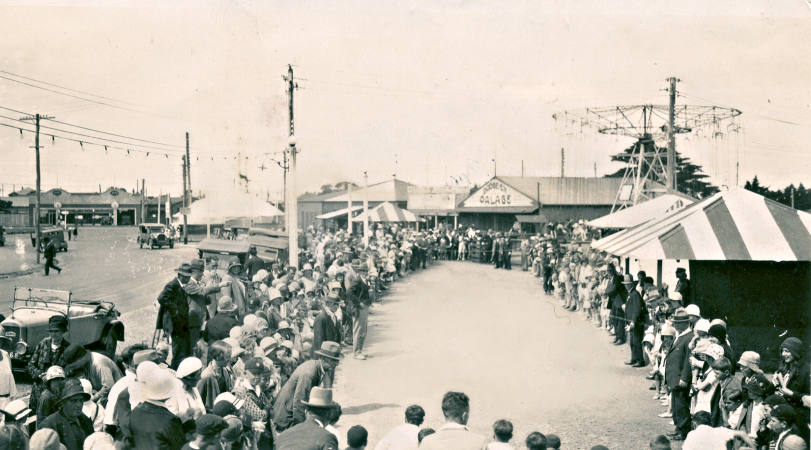
The crowd lined up watching a footrace at the Mordialloc Carnival. The carnival buildings are in the background including the Whizzy Whirl. Courtesy Mordialloc & District Historical Society.
Apart from cycle races, the Carnival Committees made sure Mordialloc was never short of creative attractions. Advertising throughout Victoria brought people to the carnival. In suburban trains, and on railway station posters, Mordialloc Carnival was featured in large advertisements. At one stage around 1940 the Carnival Committee passed a vote of thanks to E J Trait, the editor of the local Standard News, for the positive publicity given to the Mordialloc holiday fair. One local paper report in 1936 described the attendance at Mordialloc Carnival on NewYear’s Day of Haydon Bunton, a triple Brownlow Medallist, and Jack Regan, the Collingwood full back in two premiership teams (1935-6). Locals took every opportunity to put Mordialloc in the public eye. By 1935 the Carnival Committee numbered 150 with an executive of over a dozen very active workers.
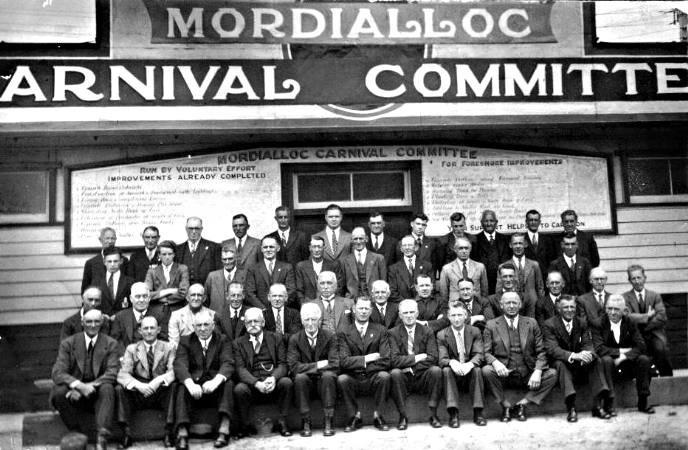
Mordialloc Carnival Committee, c1935. Courtesy Mordialloc & District Historical Society.
There were, of course, difficulties to overcome. Back in 1923 rumours were maliciously spread in the town that the rotunda was going to be built in the middle of the sportsground near the beach, thus destroying its sports capacity. Carnival men had to fiercely deny that by writing material for the local papers. In 1925 Mentone citizens ran a rival carnival in January, seeking to bring tourists to a rival town. It was a flop and never tried again. By 1927 the Carnival Committee had leased a piece of land near to the main carnival to add further attractions. However, the next year the owner of the land tried to raise its rent for the season from 50 pounds to 105 pounds, an amount the carnival committee refused to pay. The owner hired an outside showman with other entertainments to come on to his site and milk business from the patrons of the bigger funfair. Edward Brine, the president, wrote letters to local papers imploring people not to patronise this rival show, run for private profit. The appeal worked. The private show soon folded.
A big threat came in January 1936 when gaming police closed down many of the carnival’s money games saying they breached gambling laws. For example, one tent had a table painted with black and white squares like a big draughtboard. Each square was just big enough for a penny to fit inside without its edge being over the square’s side lines. People stood at barriers set a metre or so away from the table on all sides. They threw pennies on to the table and if a penny stayed inside any square a money prize of some shillings would be won. Penny Squares was rated by some people as gambling. At this time the Anglican Archbishop of Melbourne wrote an article criticising gambling and referred to the Mordialloc Carnival sideshow games in his examples of the vice. Dave White, as president of the Carnival Committee, wrote to the Standard News and expressed his disappointment that a religious leader would class the simple carnival games as gambling that had dangerous results. He pointed out to the prelate that the Carnival Committee had donated £44,000 to local works and charities over its dozen years of operation. That year the gaming police caused a big reduction in takings by closing many carnival stalls, but things changed the next year when laws were altered slightly to allow funfair activities that involved games of chance operated for fund-raising in venues such as this. Dave White, a religious man himself, supported these changes. He was in the centre of carnival organisation for many years. During the 1930s he conducted and led community singing each New Year’s Eve as the local community gathered to sing the New Year in.

Gambling at Mordialloc Carnival. Tent housing a game of chance, 1930. Courtesy Mordialloc & District Historical Society.
There were some carnival mishaps and accidents, mainly minor, but back in January 1926 the president, Cliff Caudwell, and another committee man had to jump into the creek to rescue two girls of about 12 years of age who had fallen into the water.
The last carnival of the 1930s began as war clouds enveloped Europe and Hitler’s armies began massing for a projected domination of that continent. In far away Mordialloc, the Carnival during the early forties, rather then shutting down, became a fund-raiser for the war effort and remained as popular as ever.
